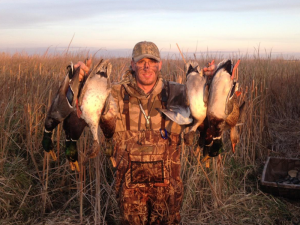The mid-continental mallard population has begun to move down the Central & Mississippi Flyways. Mallard numbers in the Dakotas and northern Nebraska increased significantly over the past week, as well as numbers in Minnesota, Wisconsin and northeastern Iowa. Diver numbers in the Great Lakes region continued to rise from Lake Superior to western basin of Lake Erie.
Hello folks, and, as always, welcome to Waterfowler.com.
A quick glance at the NOAA snow cover map reveals the mystery behind our nation’s current migration status. Accumulative snowfall across the Canadian provinces has ignited the first push of mallards into the lower-forty eight states. While a number of storms did occur in the U.S over the past fourteen days, those storms occurred below the bulk of the mallard population and have since return to average/above average temperatures, which resulted in moving early migrants further south and very few northern birds to replace them.
While the first weeks of November are traditionally host of classic clipper systems that move ducks in massive numbers, the jet-stream has remained relatively flat this autumn season and predictions fro the coming week are more of the same.
Jet-stream activity in the coming week will provide favorable migrating winds for diver species across the Great Lakes all the way to Chesapeake Bay. While these winds should increase diver activity significantly as they follow their migration path, the flatter, easterly flow is expected to stall puddle duck migration across most of the northern tier – from the Pacific Northwest all the way to Illinois.
As we approach the Thanksgiving holiday, many waterfowl hunters are already planning traditional family hunts. Holiday hunts are a great opportunity to introduce new members into the sport of waterfowl hunting and we encourage our members to reach out to first time hunters in the coming weeks. From new in-laws to family friends and growing teens, the interest in our sport has never been higher — thanks to the Duck Dynasty – and holiday hunts are the perfect way to share the true tradition and values of the hunt.
PACIFIC FLYWAY:
Duck numbers are low/average for this time of year in Washington, Oregon and Idaho. Canada Goose numbers in southern Alberta and British Columbia are increasing rapidly with duck numbers also good along the Canadian border. In the Sacramento Valley duck hunting is slow with Speck numbers average for this time of year. Snow geese have begun to arrive in northern California and hunter success was fair to good on light geese. Hunter success and duck numbers remain low from the Great Salt Lake in Utah, to southern California – where hunters await fresh birds and weather.
CENTRAL FLYWAY:
Mallard numbers are good to excellent in the Dakotas but decrease rapidly in the southern South Dakota and the Nebraska border. Gadwall, pintail, widgeon and teal are good from eastern Colorado to Kansas with duck numbers in Texas increasing as early migrating ducks move south from weather and hunting pressure. Along the Gulf coast, teal numbers are decreasing as they continue their journey south. Pintail, gadwall, redheads and canvas back numbers continue to increase and hunter success is good to excellent.
MISSISSIPPI FLYWAY:
Divers are down in Minnesota with reports of large rafts throughout the state. Mallard numbers are fair to good in western Minnesota with Canada Goose numbers good to excellent. Dangers, high winds prevailed across the northern portion of the flyway this past weekend making many large bodies of water un-huntable in MN, WI and IL. Mallard numbers increased in Iowa and western Illinois. Hunter success in the central portions of the flyway was poor to fair as early migrators continue south and few replacements arrived. The western basin of Lake Erie remains a hot-spot in the flyway with an excellent mix of divers and puddle ducks filling the daily bag. Duck numbers in the southern portion of the flyway continue to build and hunters in Louisiana reported an excellent opener with a mixed bag of early migrating ducks.
ATLANTIC FLYWAY:
Duck numbers in northeast are good to excellent at this time throughout most of the New England states – with sea ducks good to excellent along the coast. From southeastern Pennsylvania to Pamlico Sound, wood ducks and teal continue to provide the best shooting with all other species fair. With many areas between season splits, resting numbers of ducks are building from the decreased pressure. From the Carolinas to Florida, teal and wood duck numbers are good to excellent with ringed-neck ducks average for this time of year.






